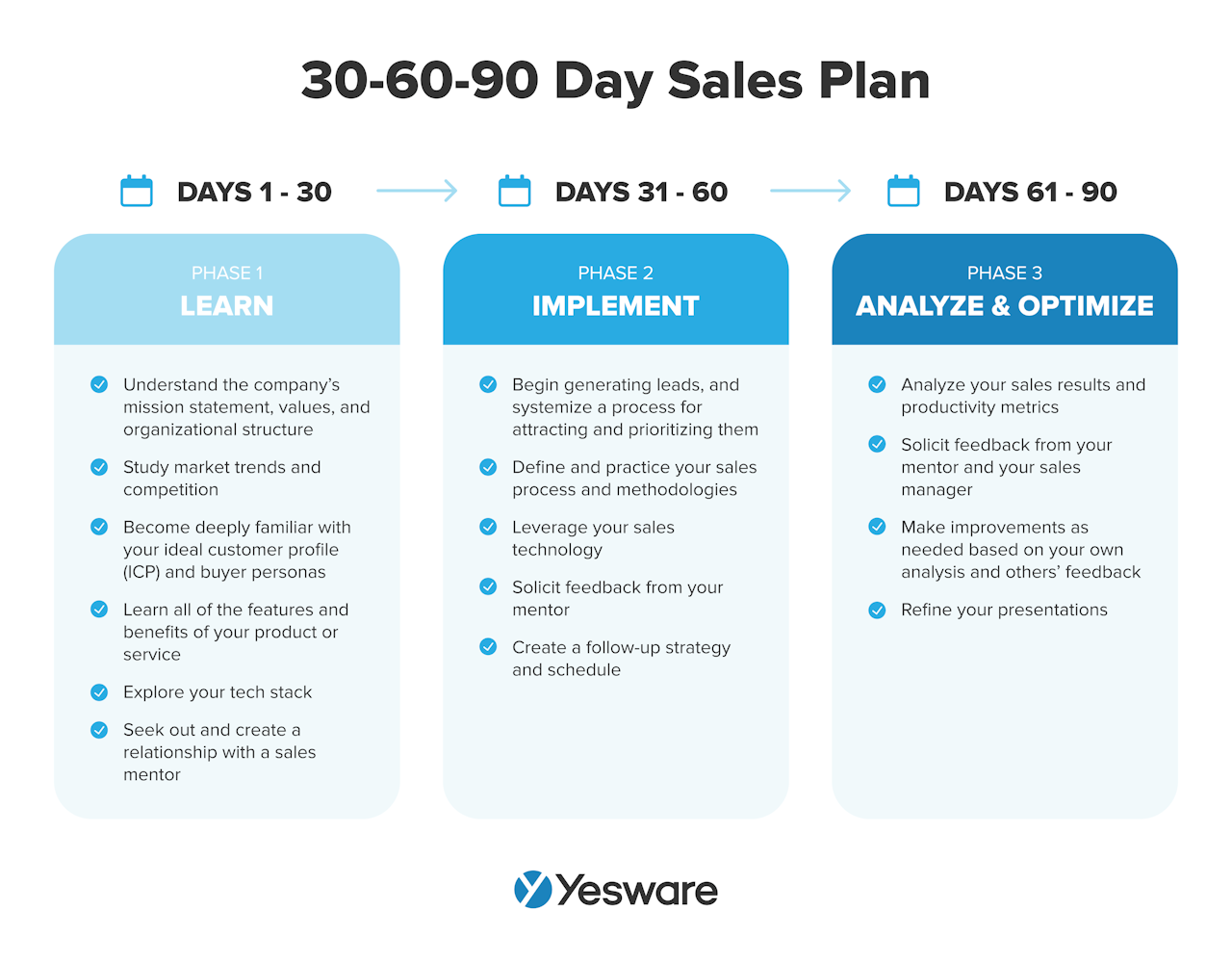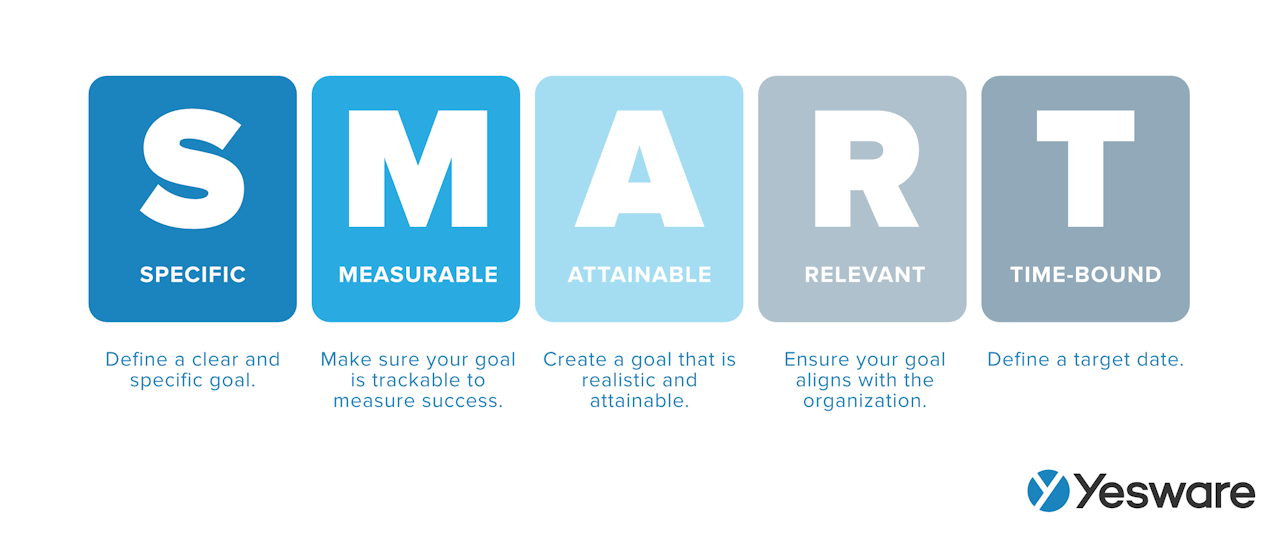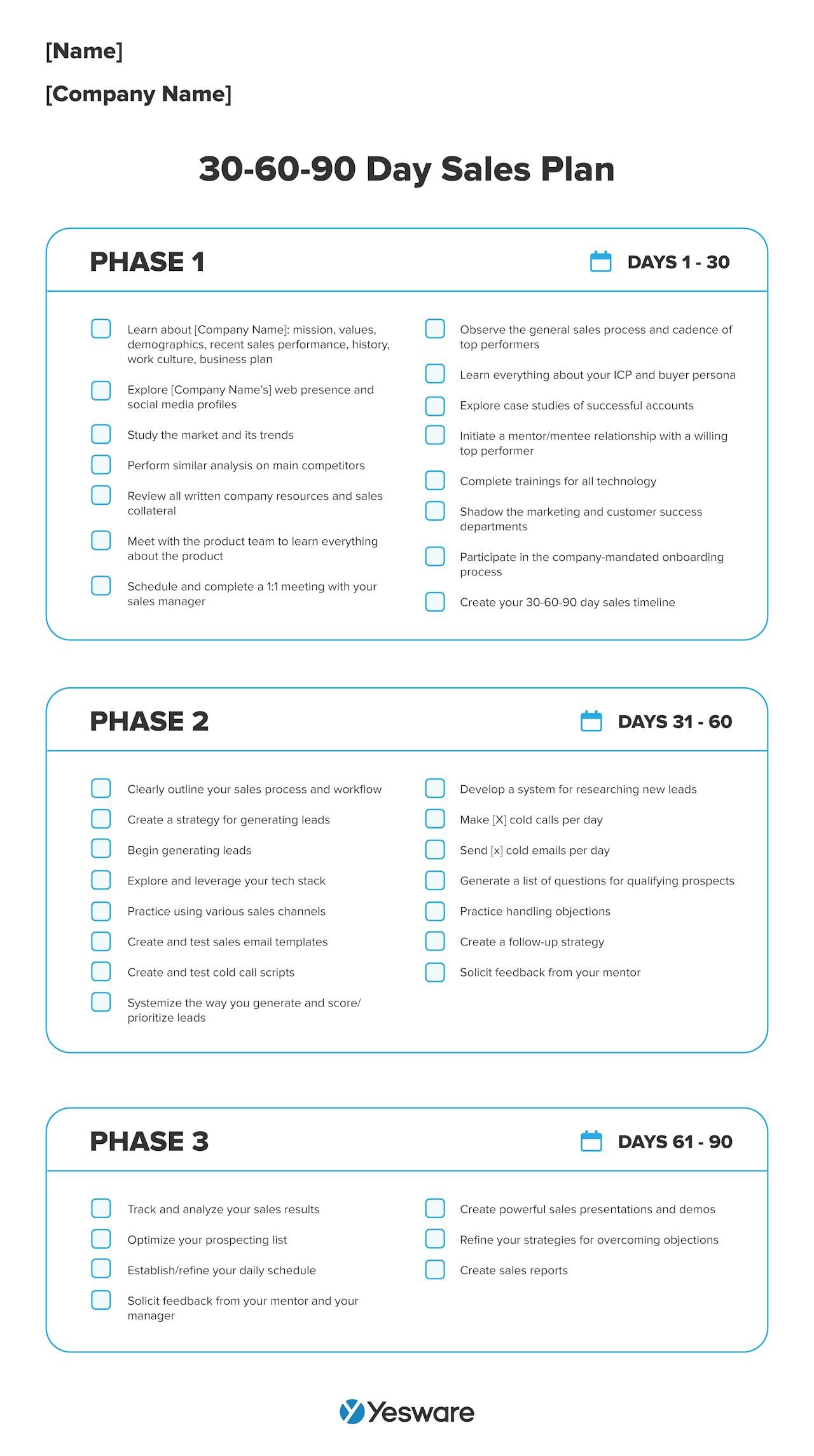How to Create a 30-60-90 Day Sales Plan [Template + Examples]
Casey O'Connor
A 30-60-90 day sales plan is a three-month sales plan that outlines the approach and specific strategies that a new sales rep or sales manager will take in their first 90 days on the job.
When a new sales rep creates a well-thought-out 30-60-90 day sales plan, it demonstrates to their team and manager that they’re a self-starter and have the skills and strategy to do their job effectively and efficiently.
In this article, we’ll go over everything you need to know about the 30-60-90 day sales plan, including why it’s so important, how to make your own, and a few examples to help you get started.
Here’s what we’ll cover:
- What Is a 30-60-90 Day Sales Plan?
- What Are the Benefits of Implementing This Sales Plan?
- How to Create a 30-60-90 Day Sales Plan
- 30-60-90 Day Sales Plan Template
- 30-60-90 Day Sales Plan Examples
What Is a 30-60-90 Day Sales Plan?
A 30-60-90 day sales plan is a clear outline of what a new salesperson or sales manager plans to learn and achieve in their first three months in the role.
Generally speaking, it’s a good idea to create your own 30-60-90 day sales plan any time you begin a new sales role. This demonstrates to the hiring manager — and, later, your new sales manager and colleagues — that you:
- Take initiative to plan for your success
- Look forward to learning about the company and integrating with the current team
- Have specific ideas about how to add value to the organization
If you don’t create your own 30-60-90 day sales plan, some managers will make one for you. They may ask you to adhere to it as they evaluate your progress and offer feedback about your initial performance.
Each 30-60-90 day sales plan is unique, as they’re created based on the specific goals, skills, and organizational specifics of each individual sales professional and their company.
That being said, they all generally tend to follow a similar framework: learn – implement – analyze & optimize.
 A carefully-crafted 30-60-90 day sales plan makes a fantastic first impression for anyone in a new sales role, from entry-level rep to high-level management. It demonstrates your vision for how you plan to contribute to the overall success of the company, as well as the exact steps you’ll take to meet those goals.
A carefully-crafted 30-60-90 day sales plan makes a fantastic first impression for anyone in a new sales role, from entry-level rep to high-level management. It demonstrates your vision for how you plan to contribute to the overall success of the company, as well as the exact steps you’ll take to meet those goals.
This kind of initiative does not go unnoticed in a sales interview, and — when you eventually get the job — will help the onboarding process run as smoothly as possible. A great 30-60-90 day sales plan can significantly reduce ramp-up time and increase productivity in new hires.
What Are the Benefits of Implementing This Sales Plan?
There is very little downside to creating and implementing a 30-60-90 day sales plan. Although there is a bit of legwork involved in the process, the results are well worth it. Remember — failure to plan is a plan to fail.
The benefits of this plan, on the other hand, are numerous and significant. Both individual sales reps/managers and overall organizations alike benefit from the structure and focus on results that 30-60-90 day sales plans provide.
Empowers Employees to Position Themselves for Success
When a salesperson takes on a new position, a 30-60-90 day sales plan can help them onboard with intention.
Not only does this kind of plan demonstrate to the manager that you’re serious about your (and the company’s) success, but it also helps outline the responsibilities of your new role for your own day-to-day benefit. It gives you an easy-to-follow plan as you navigate the challenges of starting a new position.
It also helps new sales reps and managers create and work toward sales goals in a scalable and sustainable way.
Enables Managers to Maximize Their Resources
Every sales manager appreciates when a new employee creates their own 30-60-90 day sales plan. Not only does it help ensure the success of the incoming rep, but it also enables the sales manager to make the most of their new talent and appropriately plan the way they’re going to use their resources.
A 30-60-90 day sales plan can also help highlight any misconceptions or misalignments the new employee has relative to their new role, or the organization as a whole. It creates a good opportunity for management and new hires to become fully in sync as they understand the scope of the job and define success in the role.
Creates Team-Wide Transparency
A 30-60-90 day sales plan can help foster trust between a new sales hire and their colleagues. It proves that the new hire is capable of taking initiative and meeting goals independently, and gives a clear indication of how the new hire will contribute to the team.
How to Create a 30-60-90-Day Sales Plan
As mentioned above, each 30-60-90 day sales plan is highly unique. There is no one formula that will help sales professionals create a “perfect” plan.
There is, however, a general framework of steps that you can follow that will help you create a robust 30-60-90 day sales plan that’s specific to the organization with which you’re working.
Note that there are several opportunities for goal-setting within the 30-60-90 day sales plan. It’s best practice (and will save a lot of time and effort in the long run) to use the SMART goal framework when creating goals. With that in mind, here’s a basic outline of how to create a 30-60-90 day sales plan.
With that in mind, here’s a basic outline of how to create a 30-60-90 day sales plan.
1. Research Your New Employer
Before a sales interview, or at least before onboarding at a new company, learn as much as you can about their business — who they serve, what they offer, and with whom they mainly compete. Generate a list of questions to ask about their operation and/or their goals.
2. Identify Your New Organization’s Goals
As soon as you can, try to find out some of the company’s business or sales goals. You might learn about these through a sales interview; you could also gather this kind of information from social media or through LinkedIn.
The point is to learn enough about some of the things the company is hoping to achieve; you can then speak to those goals in your 30-60-90 day sales plan.
You’ll also want to ask if they have any goals for you as an individual. They might, for example, have a certain sales quota they’d like you to meet. These should also be incorporated into your 30-60-90 day sales plan.
This takes a little extra effort, but it’s likely to resonate with a hiring or sales manager. It shows that you’re a team player, and that you have the skillset to help the company successfully reach their goals.
3. Determine Your Own Priorities
It’s also important to take into consideration your own strengths and career goals when you’re making your 30-60-90 day sales plan.
See how closely you can align your own professional priorities with those of the company; the more you can find ways to show that the two complement one another, the better off you’ll be.
4. Create a Timeline and Indicate How You’ll Measure Success
Some parts of your 30-60-90 day sales plan might be easy to measure. In Phase 2, for example, you might indicate that you plan to make 50 sales calls per day. That’s a metric that will be easy to account for and evaluate.
Other components, though, might be tricker to define. In Phase 3, you might plan to “improve the way you handle objections.” This isn’t the most straightforward or tangible progress indicator, but it can be measured.
A sales rep might determine that they’ve met this goal when they can speak confidently to a range of objections during a role play exercise, with fewer than 5 “errors,” with errors defined as extended pauses or verbal miscues.
You’ll also want to assign timelines to each action or intended achievement. Being able to measure and put a timeframe on your goals are both important parts of the SMART goal framework.
The more specifically you can measure your progress, the more effective your plan will be.
Tip: Growing your sales team? Grab some data-backed findings and strategies below.
 How to Scale a B2B Sales Team from 2 to 20 Sales Reps in 12 MonthsA step-by-step blueprint and action plan for growing a sales team in a way that maximizes profitability.
How to Scale a B2B Sales Team from 2 to 20 Sales Reps in 12 MonthsA step-by-step blueprint and action plan for growing a sales team in a way that maximizes profitability.
30-60-90-Day Sales Plan Template
The following template is an extensive and overarching checklist; not every item will apply to every salesperson or company. Similarly, you may find that you need to add additional components that are unique to your employment situation.
 If you’re interested in the checklist above — grab the Google Docs version of it here.
If you’re interested in the checklist above — grab the Google Docs version of it here.
To make it your own, click “File” and select “Make a copy.”
Feel free to remove or add any items from this list; treat this as a template or guide and edit as needed for your circumstances.
30-60-90-Day Sales Plan Examples
Below are three examples of real-world 30-60-90 day sales plans. The first two are great examples of use cases we’ve outlined here in this article: a new sales rep and a new sales manager.
Note, though, that there’s a third use case that we didn’t explore as fully: a new sales territory. The same basic principles of the 30-60-90 day sales plan apply similarly to this topic.
As always, feel free to use and adapt as you see fit according to your specific circumstances.
New Sales Rep
This 30-60-90 day sales plan example is perfect for a salesperson starting a new position as a sales rep.
Phase 1
- Complete all company-run onboarding, training, and/or coaching
- Learn about the company’s mission, values, and culture
- Become fluent in the specifics of the product and/or service
- Research the target market and ICP, and learn how to reach and communicate with your specific buyer personas
- Learn the names and roles of everyone on the team
- Schedule periodic check-ins with a mentor and/or managers to discuss progress
- Research your company’s competitors
Phase 2
- Identify a top performer who is willing to let you shadow them, and schedule a few times to do so
- Practice interacting with prospects
- Role play different sales scenarios with your mentor or other top performers
- Set sales goals using the SMART goal framework
- Keep a clear record/detailed notes about all of your sales activities so that you can optimize the process in the future
- Create a follow-up strategy and schedule
Phase 3
- Review your notes and identify areas of strength and improvement
- Make tweaks to your sales process and test them
- Create and stick to a daily schedule that aligns with your productivity goals
- Solicit feedback and incorporate it into your process
New Sales Manager
This 30-60-90 day sales plan example is perfect for a salesperson starting a new position as a sales manager.
Phase 1
- Identify key professional and personal pieces of information about every team member (i.e., birthday, kids’ names, preferred work environment, preferred method of communication)
- Identify any sales management tools you need, including technology like a CRM system
- Perform thorough research on the competition and current and historical market trends
- Study team sales reports to identify collective and individual strengths and weaknesses
- Observe and record the day-to-day operations of team members
- Implement at least one small change based on feedback from the team
Phase 2
- Identify skills gaps or areas of growth, both individually and team-wide
- Set new SMART goals for the team based on analysis and sales reports
- Make at least one small change to support the team
- Continue collecting and analyzing data
- Meet 1:1 with team members to offer and solicit feedback
Phase 3
- Create a strategy for new training/coaching
- Collect data and run analysis on how your new strategy could generate more revenue
- Create a structured schedule that implements any changes
New Sales Territory
This 30-60-90 day sales plan example is perfect for a sales team that’s entering into a new sales territory.
Phase 1
- Define the market/trends of the new sales territory
- Learn about the competition in the new territory, local or otherwise
- Study and understand the demographics of the new territory
- Identify ways to tweak your sales strategies based on demographics
- Perform a SWOT analysis to determine viability
- Build the ICP and buyer personas for the new territory
- Identify the most profitable accounts in the new territory
Phase 2
- Create SMART sales goals
- Decide which KPIs to focus on and design a system for tracking and recording them
- Generate new leads
Phase 3
- Ask for feedback from team members, prospects, and customers
- Implement feedback as you optimize your process
- Outline your sales forecast for the next quarter/remainder of the year
- Create a sales process and workflows that align with your goals and forecast
Have you created and/or followed a 30-60-90 day sales plan before? How did it improve your sales process? Would onboarding have been more challenging without one?
Tip: Looking for more sales plan templates? Grab them here –> 13 Sales Plan Templates.
Get sales tips and strategies delivered straight to your inbox.
Yesware will help you generate more sales right from your inbox. Try our Outlook add-on or Gmail Chrome extension for free, forever!
Related Articles
Casey O'Connor
Casey O'Connor
Anya Vitko
Sales, deal management, and communication tips for your inbox
![How to Create a 30-60-90 Day Sales Plan [Template + Examples]](/blog/_next/image/?url=https%3A%2F%2Fwww.yesware.com%2Fwp-content%2Fuploads%2F2022%2F09%2F30-60-90-day-sales-plan-cover-yesware.jpg&w=1984&q=75)
